Liability of Employer for Employee Misconduct
VerifiedAdded on 2020/07/22
|9
|2995
|40
AI Summary
The assignment discusses the liability of an employer (Newtown) for the misconduct of its employees who caused damage to a machine and seriously harmed youth by trespassing onto their land. The scenario highlights the concept of vicarious liability, where employers are held responsible for the actions of their employees. It references relevant case law, including Sheffield and Lincolnshire Railway Co (1873), Limpus v London General Omnibus (1860), and Nettleship v Weston (1971), to illustrate the principles of employer responsibility in construction law.
Contribute Materials
Your contribution can guide someone’s learning journey. Share your
documents today.

Property law
1
1
Secure Best Marks with AI Grader
Need help grading? Try our AI Grader for instant feedback on your assignments.
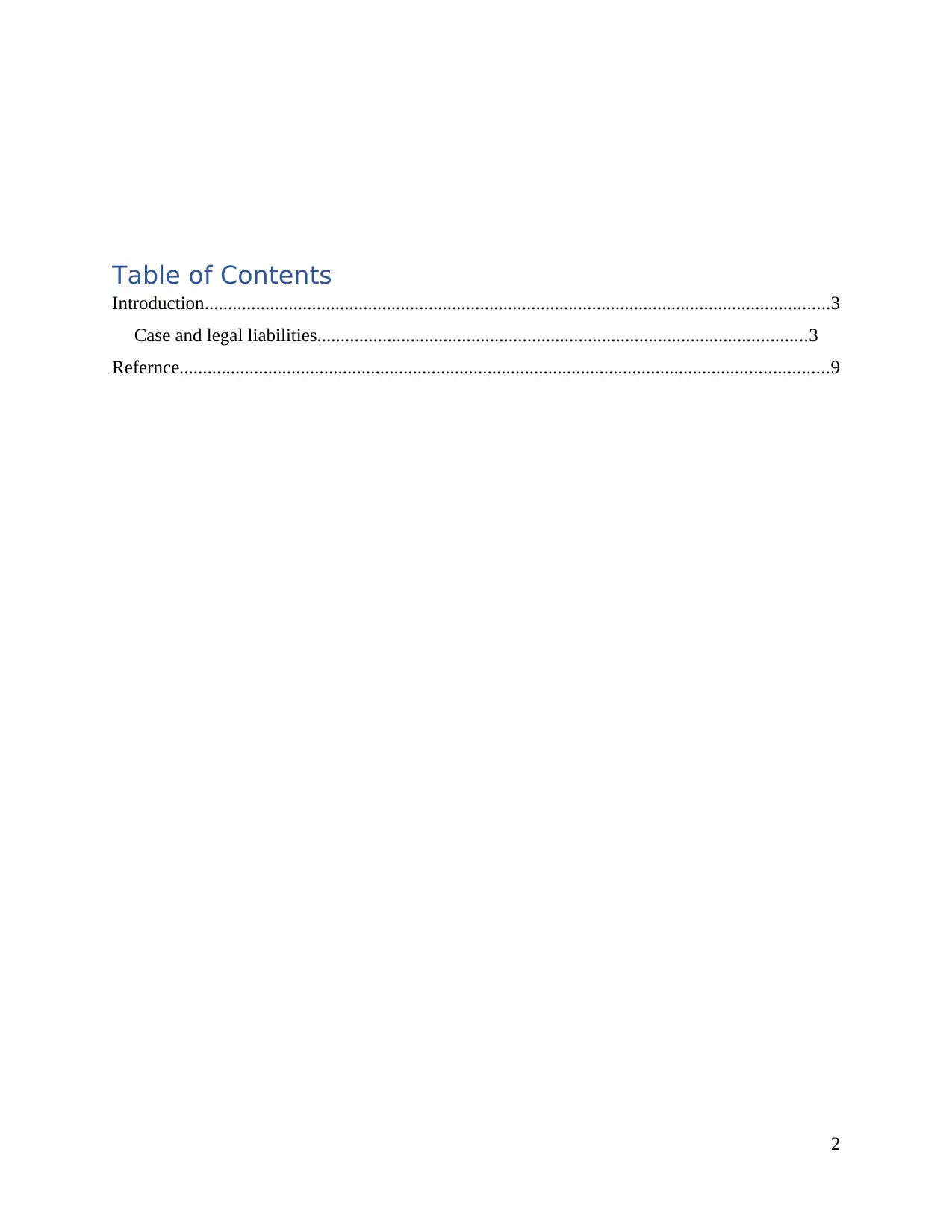
Table of Contents
Introduction......................................................................................................................................3
Case and legal liabilities.........................................................................................................3
Refernce...........................................................................................................................................9
2
Introduction......................................................................................................................................3
Case and legal liabilities.........................................................................................................3
Refernce...........................................................................................................................................9
2
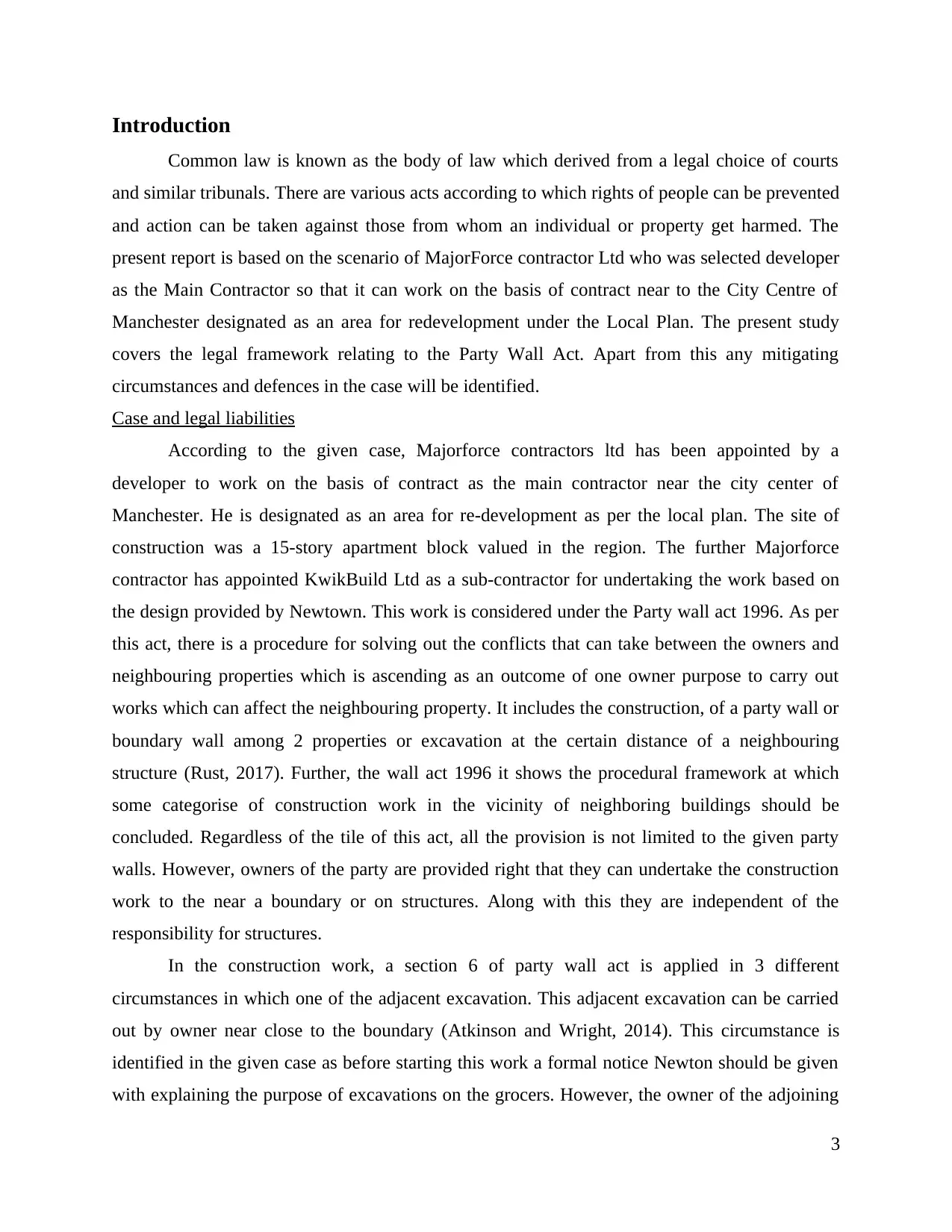
Introduction
Common law is known as the body of law which derived from a legal choice of courts
and similar tribunals. There are various acts according to which rights of people can be prevented
and action can be taken against those from whom an individual or property get harmed. The
present report is based on the scenario of MajorForce contractor Ltd who was selected developer
as the Main Contractor so that it can work on the basis of contract near to the City Centre of
Manchester designated as an area for redevelopment under the Local Plan. The present study
covers the legal framework relating to the Party Wall Act. Apart from this any mitigating
circumstances and defences in the case will be identified.
Case and legal liabilities
According to the given case, Majorforce contractors ltd has been appointed by a
developer to work on the basis of contract as the main contractor near the city center of
Manchester. He is designated as an area for re-development as per the local plan. The site of
construction was a 15-story apartment block valued in the region. The further Majorforce
contractor has appointed KwikBuild Ltd as a sub-contractor for undertaking the work based on
the design provided by Newtown. This work is considered under the Party wall act 1996. As per
this act, there is a procedure for solving out the conflicts that can take between the owners and
neighbouring properties which is ascending as an outcome of one owner purpose to carry out
works which can affect the neighbouring property. It includes the construction, of a party wall or
boundary wall among 2 properties or excavation at the certain distance of a neighbouring
structure (Rust, 2017). Further, the wall act 1996 it shows the procedural framework at which
some categorise of construction work in the vicinity of neighboring buildings should be
concluded. Regardless of the tile of this act, all the provision is not limited to the given party
walls. However, owners of the party are provided right that they can undertake the construction
work to the near a boundary or on structures. Along with this they are independent of the
responsibility for structures.
In the construction work, a section 6 of party wall act is applied in 3 different
circumstances in which one of the adjacent excavation. This adjacent excavation can be carried
out by owner near close to the boundary (Atkinson and Wright, 2014). This circumstance is
identified in the given case as before starting this work a formal notice Newton should be given
with explaining the purpose of excavations on the grocers. However, the owner of the adjoining
3
Common law is known as the body of law which derived from a legal choice of courts
and similar tribunals. There are various acts according to which rights of people can be prevented
and action can be taken against those from whom an individual or property get harmed. The
present report is based on the scenario of MajorForce contractor Ltd who was selected developer
as the Main Contractor so that it can work on the basis of contract near to the City Centre of
Manchester designated as an area for redevelopment under the Local Plan. The present study
covers the legal framework relating to the Party Wall Act. Apart from this any mitigating
circumstances and defences in the case will be identified.
Case and legal liabilities
According to the given case, Majorforce contractors ltd has been appointed by a
developer to work on the basis of contract as the main contractor near the city center of
Manchester. He is designated as an area for re-development as per the local plan. The site of
construction was a 15-story apartment block valued in the region. The further Majorforce
contractor has appointed KwikBuild Ltd as a sub-contractor for undertaking the work based on
the design provided by Newtown. This work is considered under the Party wall act 1996. As per
this act, there is a procedure for solving out the conflicts that can take between the owners and
neighbouring properties which is ascending as an outcome of one owner purpose to carry out
works which can affect the neighbouring property. It includes the construction, of a party wall or
boundary wall among 2 properties or excavation at the certain distance of a neighbouring
structure (Rust, 2017). Further, the wall act 1996 it shows the procedural framework at which
some categorise of construction work in the vicinity of neighboring buildings should be
concluded. Regardless of the tile of this act, all the provision is not limited to the given party
walls. However, owners of the party are provided right that they can undertake the construction
work to the near a boundary or on structures. Along with this they are independent of the
responsibility for structures.
In the construction work, a section 6 of party wall act is applied in 3 different
circumstances in which one of the adjacent excavation. This adjacent excavation can be carried
out by owner near close to the boundary (Atkinson and Wright, 2014). This circumstance is
identified in the given case as before starting this work a formal notice Newton should be given
with explaining the purpose of excavations on the grocers. However, the owner of the adjoining
3
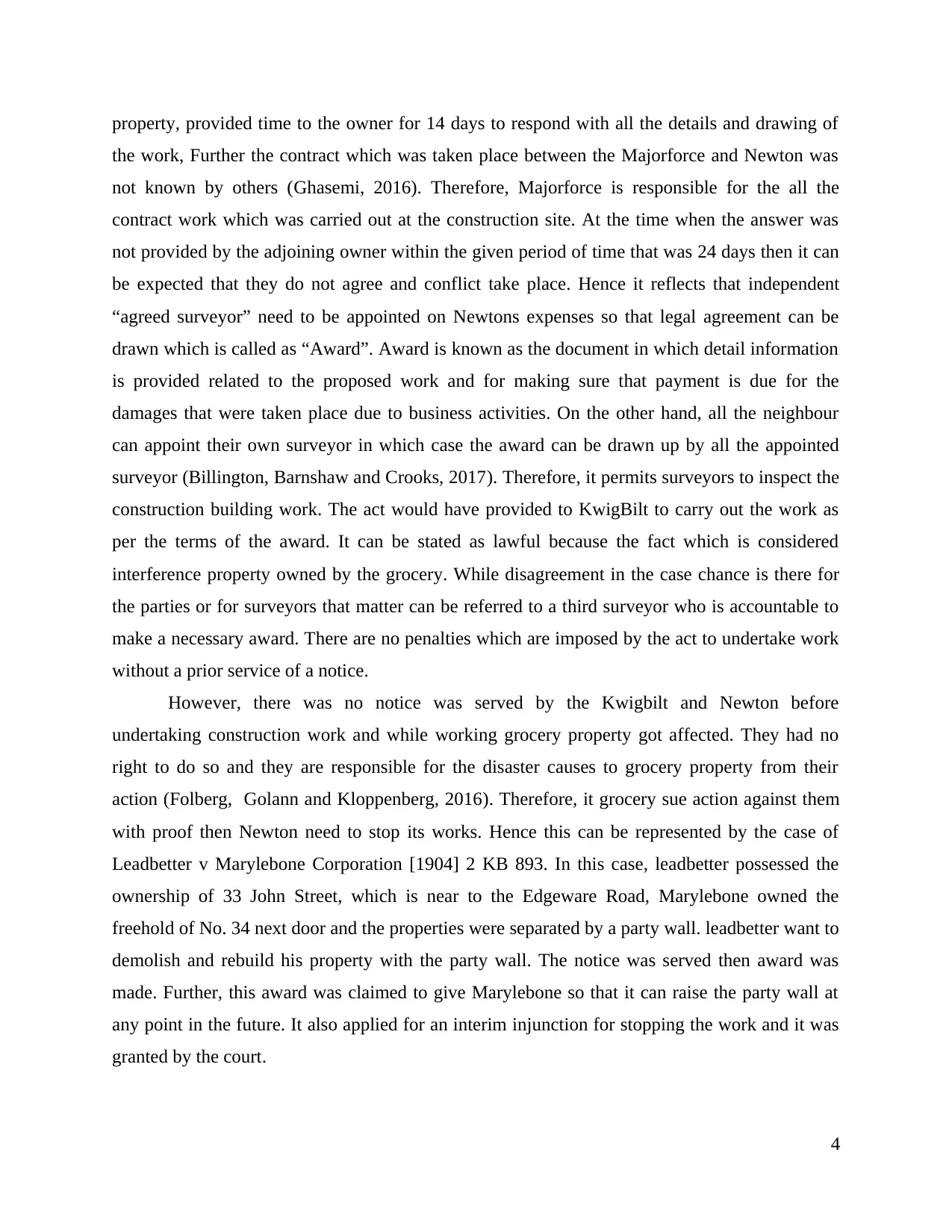
property, provided time to the owner for 14 days to respond with all the details and drawing of
the work, Further the contract which was taken place between the Majorforce and Newton was
not known by others (Ghasemi, 2016). Therefore, Majorforce is responsible for the all the
contract work which was carried out at the construction site. At the time when the answer was
not provided by the adjoining owner within the given period of time that was 24 days then it can
be expected that they do not agree and conflict take place. Hence it reflects that independent
“agreed surveyor” need to be appointed on Newtons expenses so that legal agreement can be
drawn which is called as “Award”. Award is known as the document in which detail information
is provided related to the proposed work and for making sure that payment is due for the
damages that were taken place due to business activities. On the other hand, all the neighbour
can appoint their own surveyor in which case the award can be drawn up by all the appointed
surveyor (Billington, Barnshaw and Crooks, 2017). Therefore, it permits surveyors to inspect the
construction building work. The act would have provided to KwigBilt to carry out the work as
per the terms of the award. It can be stated as lawful because the fact which is considered
interference property owned by the grocery. While disagreement in the case chance is there for
the parties or for surveyors that matter can be referred to a third surveyor who is accountable to
make a necessary award. There are no penalties which are imposed by the act to undertake work
without a prior service of a notice.
However, there was no notice was served by the Kwigbilt and Newton before
undertaking construction work and while working grocery property got affected. They had no
right to do so and they are responsible for the disaster causes to grocery property from their
action (Folberg, Golann and Kloppenberg, 2016). Therefore, it grocery sue action against them
with proof then Newton need to stop its works. Hence this can be represented by the case of
Leadbetter v Marylebone Corporation [1904] 2 KB 893. In this case, leadbetter possessed the
ownership of 33 John Street, which is near to the Edgeware Road, Marylebone owned the
freehold of No. 34 next door and the properties were separated by a party wall. leadbetter want to
demolish and rebuild his property with the party wall. The notice was served then award was
made. Further, this award was claimed to give Marylebone so that it can raise the party wall at
any point in the future. It also applied for an interim injunction for stopping the work and it was
granted by the court.
4
the work, Further the contract which was taken place between the Majorforce and Newton was
not known by others (Ghasemi, 2016). Therefore, Majorforce is responsible for the all the
contract work which was carried out at the construction site. At the time when the answer was
not provided by the adjoining owner within the given period of time that was 24 days then it can
be expected that they do not agree and conflict take place. Hence it reflects that independent
“agreed surveyor” need to be appointed on Newtons expenses so that legal agreement can be
drawn which is called as “Award”. Award is known as the document in which detail information
is provided related to the proposed work and for making sure that payment is due for the
damages that were taken place due to business activities. On the other hand, all the neighbour
can appoint their own surveyor in which case the award can be drawn up by all the appointed
surveyor (Billington, Barnshaw and Crooks, 2017). Therefore, it permits surveyors to inspect the
construction building work. The act would have provided to KwigBilt to carry out the work as
per the terms of the award. It can be stated as lawful because the fact which is considered
interference property owned by the grocery. While disagreement in the case chance is there for
the parties or for surveyors that matter can be referred to a third surveyor who is accountable to
make a necessary award. There are no penalties which are imposed by the act to undertake work
without a prior service of a notice.
However, there was no notice was served by the Kwigbilt and Newton before
undertaking construction work and while working grocery property got affected. They had no
right to do so and they are responsible for the disaster causes to grocery property from their
action (Folberg, Golann and Kloppenberg, 2016). Therefore, it grocery sue action against them
with proof then Newton need to stop its works. Hence this can be represented by the case of
Leadbetter v Marylebone Corporation [1904] 2 KB 893. In this case, leadbetter possessed the
ownership of 33 John Street, which is near to the Edgeware Road, Marylebone owned the
freehold of No. 34 next door and the properties were separated by a party wall. leadbetter want to
demolish and rebuild his property with the party wall. The notice was served then award was
made. Further, this award was claimed to give Marylebone so that it can raise the party wall at
any point in the future. It also applied for an interim injunction for stopping the work and it was
granted by the court.
4
Secure Best Marks with AI Grader
Need help grading? Try our AI Grader for instant feedback on your assignments.
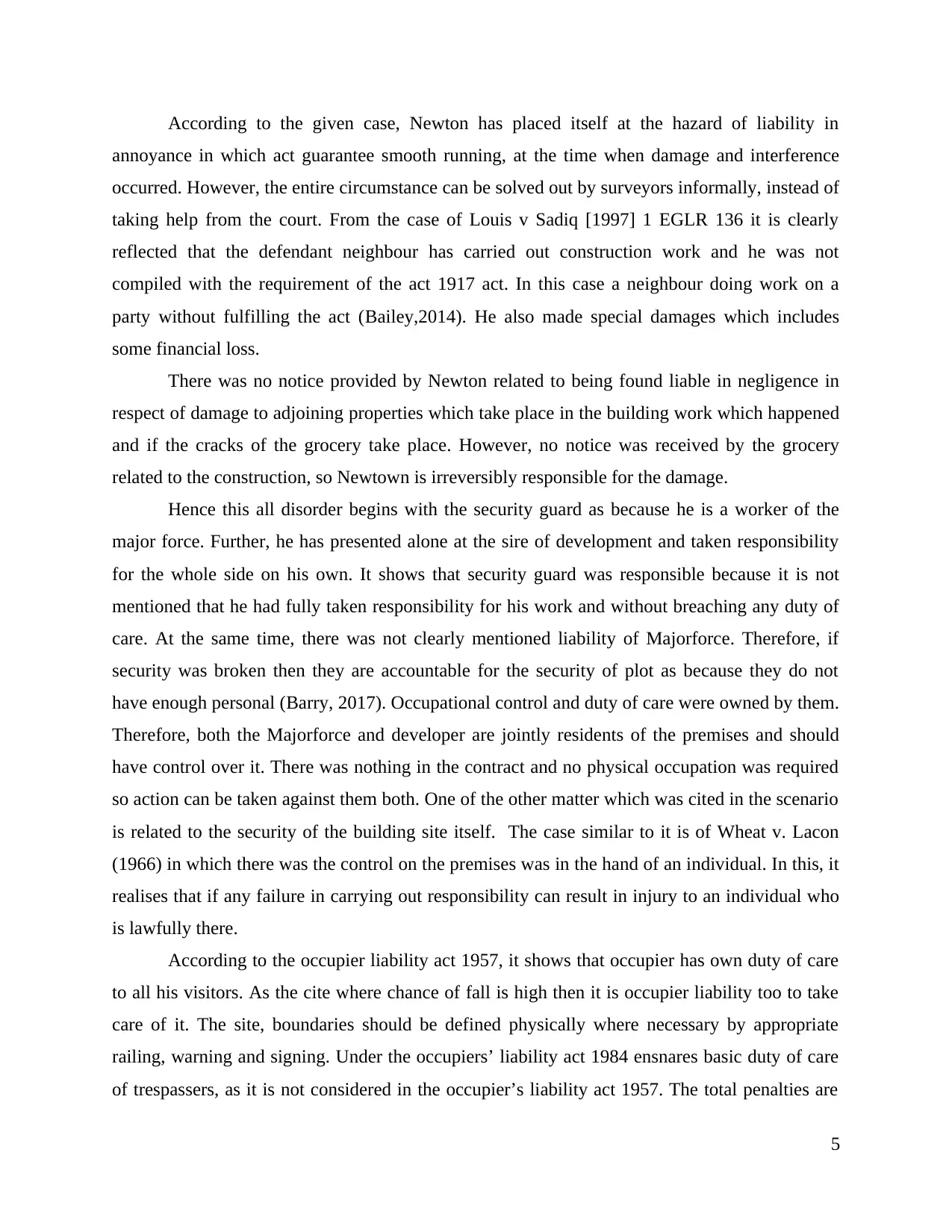
According to the given case, Newton has placed itself at the hazard of liability in
annoyance in which act guarantee smooth running, at the time when damage and interference
occurred. However, the entire circumstance can be solved out by surveyors informally, instead of
taking help from the court. From the case of Louis v Sadiq [1997] 1 EGLR 136 it is clearly
reflected that the defendant neighbour has carried out construction work and he was not
compiled with the requirement of the act 1917 act. In this case a neighbour doing work on a
party without fulfilling the act (Bailey,2014). He also made special damages which includes
some financial loss.
There was no notice provided by Newton related to being found liable in negligence in
respect of damage to adjoining properties which take place in the building work which happened
and if the cracks of the grocery take place. However, no notice was received by the grocery
related to the construction, so Newtown is irreversibly responsible for the damage.
Hence this all disorder begins with the security guard as because he is a worker of the
major force. Further, he has presented alone at the sire of development and taken responsibility
for the whole side on his own. It shows that security guard was responsible because it is not
mentioned that he had fully taken responsibility for his work and without breaching any duty of
care. At the same time, there was not clearly mentioned liability of Majorforce. Therefore, if
security was broken then they are accountable for the security of plot as because they do not
have enough personal (Barry, 2017). Occupational control and duty of care were owned by them.
Therefore, both the Majorforce and developer are jointly residents of the premises and should
have control over it. There was nothing in the contract and no physical occupation was required
so action can be taken against them both. One of the other matter which was cited in the scenario
is related to the security of the building site itself. The case similar to it is of Wheat v. Lacon
(1966) in which there was the control on the premises was in the hand of an individual. In this, it
realises that if any failure in carrying out responsibility can result in injury to an individual who
is lawfully there.
According to the occupier liability act 1957, it shows that occupier has own duty of care
to all his visitors. As the cite where chance of fall is high then it is occupier liability too to take
care of it. The site, boundaries should be defined physically where necessary by appropriate
railing, warning and signing. Under the occupiers’ liability act 1984 ensnares basic duty of care
of trespassers, as it is not considered in the occupier’s liability act 1957. The total penalties are
5
annoyance in which act guarantee smooth running, at the time when damage and interference
occurred. However, the entire circumstance can be solved out by surveyors informally, instead of
taking help from the court. From the case of Louis v Sadiq [1997] 1 EGLR 136 it is clearly
reflected that the defendant neighbour has carried out construction work and he was not
compiled with the requirement of the act 1917 act. In this case a neighbour doing work on a
party without fulfilling the act (Bailey,2014). He also made special damages which includes
some financial loss.
There was no notice provided by Newton related to being found liable in negligence in
respect of damage to adjoining properties which take place in the building work which happened
and if the cracks of the grocery take place. However, no notice was received by the grocery
related to the construction, so Newtown is irreversibly responsible for the damage.
Hence this all disorder begins with the security guard as because he is a worker of the
major force. Further, he has presented alone at the sire of development and taken responsibility
for the whole side on his own. It shows that security guard was responsible because it is not
mentioned that he had fully taken responsibility for his work and without breaching any duty of
care. At the same time, there was not clearly mentioned liability of Majorforce. Therefore, if
security was broken then they are accountable for the security of plot as because they do not
have enough personal (Barry, 2017). Occupational control and duty of care were owned by them.
Therefore, both the Majorforce and developer are jointly residents of the premises and should
have control over it. There was nothing in the contract and no physical occupation was required
so action can be taken against them both. One of the other matter which was cited in the scenario
is related to the security of the building site itself. The case similar to it is of Wheat v. Lacon
(1966) in which there was the control on the premises was in the hand of an individual. In this, it
realises that if any failure in carrying out responsibility can result in injury to an individual who
is lawfully there.
According to the occupier liability act 1957, it shows that occupier has own duty of care
to all his visitors. As the cite where chance of fall is high then it is occupier liability too to take
care of it. The site, boundaries should be defined physically where necessary by appropriate
railing, warning and signing. Under the occupiers’ liability act 1984 ensnares basic duty of care
of trespassers, as it is not considered in the occupier’s liability act 1957. The total penalties are
5
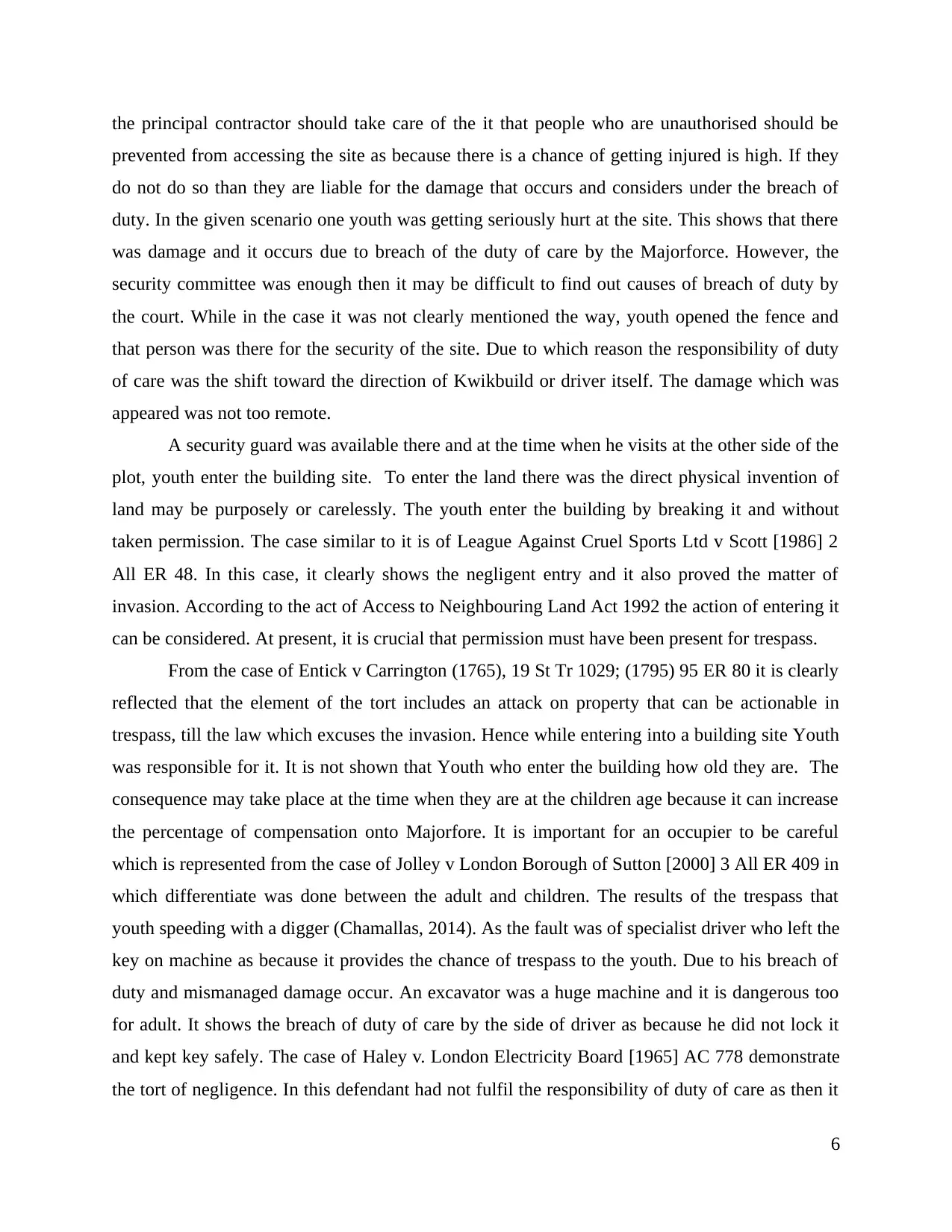
the principal contractor should take care of the it that people who are unauthorised should be
prevented from accessing the site as because there is a chance of getting injured is high. If they
do not do so than they are liable for the damage that occurs and considers under the breach of
duty. In the given scenario one youth was getting seriously hurt at the site. This shows that there
was damage and it occurs due to breach of the duty of care by the Majorforce. However, the
security committee was enough then it may be difficult to find out causes of breach of duty by
the court. While in the case it was not clearly mentioned the way, youth opened the fence and
that person was there for the security of the site. Due to which reason the responsibility of duty
of care was the shift toward the direction of Kwikbuild or driver itself. The damage which was
appeared was not too remote.
A security guard was available there and at the time when he visits at the other side of the
plot, youth enter the building site. To enter the land there was the direct physical invention of
land may be purposely or carelessly. The youth enter the building by breaking it and without
taken permission. The case similar to it is of League Against Cruel Sports Ltd v Scott [1986] 2
All ER 48. In this case, it clearly shows the negligent entry and it also proved the matter of
invasion. According to the act of Access to Neighbouring Land Act 1992 the action of entering it
can be considered. At present, it is crucial that permission must have been present for trespass.
From the case of Entick v Carrington (1765), 19 St Tr 1029; (1795) 95 ER 80 it is clearly
reflected that the element of the tort includes an attack on property that can be actionable in
trespass, till the law which excuses the invasion. Hence while entering into a building site Youth
was responsible for it. It is not shown that Youth who enter the building how old they are. The
consequence may take place at the time when they are at the children age because it can increase
the percentage of compensation onto Majorfore. It is important for an occupier to be careful
which is represented from the case of Jolley v London Borough of Sutton [2000] 3 All ER 409 in
which differentiate was done between the adult and children. The results of the trespass that
youth speeding with a digger (Chamallas, 2014). As the fault was of specialist driver who left the
key on machine as because it provides the chance of trespass to the youth. Due to his breach of
duty and mismanaged damage occur. An excavator was a huge machine and it is dangerous too
for adult. It shows the breach of duty of care by the side of driver as because he did not lock it
and kept key safely. The case of Haley v. London Electricity Board [1965] AC 778 demonstrate
the tort of negligence. In this defendant had not fulfil the responsibility of duty of care as then it
6
prevented from accessing the site as because there is a chance of getting injured is high. If they
do not do so than they are liable for the damage that occurs and considers under the breach of
duty. In the given scenario one youth was getting seriously hurt at the site. This shows that there
was damage and it occurs due to breach of the duty of care by the Majorforce. However, the
security committee was enough then it may be difficult to find out causes of breach of duty by
the court. While in the case it was not clearly mentioned the way, youth opened the fence and
that person was there for the security of the site. Due to which reason the responsibility of duty
of care was the shift toward the direction of Kwikbuild or driver itself. The damage which was
appeared was not too remote.
A security guard was available there and at the time when he visits at the other side of the
plot, youth enter the building site. To enter the land there was the direct physical invention of
land may be purposely or carelessly. The youth enter the building by breaking it and without
taken permission. The case similar to it is of League Against Cruel Sports Ltd v Scott [1986] 2
All ER 48. In this case, it clearly shows the negligent entry and it also proved the matter of
invasion. According to the act of Access to Neighbouring Land Act 1992 the action of entering it
can be considered. At present, it is crucial that permission must have been present for trespass.
From the case of Entick v Carrington (1765), 19 St Tr 1029; (1795) 95 ER 80 it is clearly
reflected that the element of the tort includes an attack on property that can be actionable in
trespass, till the law which excuses the invasion. Hence while entering into a building site Youth
was responsible for it. It is not shown that Youth who enter the building how old they are. The
consequence may take place at the time when they are at the children age because it can increase
the percentage of compensation onto Majorfore. It is important for an occupier to be careful
which is represented from the case of Jolley v London Borough of Sutton [2000] 3 All ER 409 in
which differentiate was done between the adult and children. The results of the trespass that
youth speeding with a digger (Chamallas, 2014). As the fault was of specialist driver who left the
key on machine as because it provides the chance of trespass to the youth. Due to his breach of
duty and mismanaged damage occur. An excavator was a huge machine and it is dangerous too
for adult. It shows the breach of duty of care by the side of driver as because he did not lock it
and kept key safely. The case of Haley v. London Electricity Board [1965] AC 778 demonstrate
the tort of negligence. In this defendant had not fulfil the responsibility of duty of care as then it
6
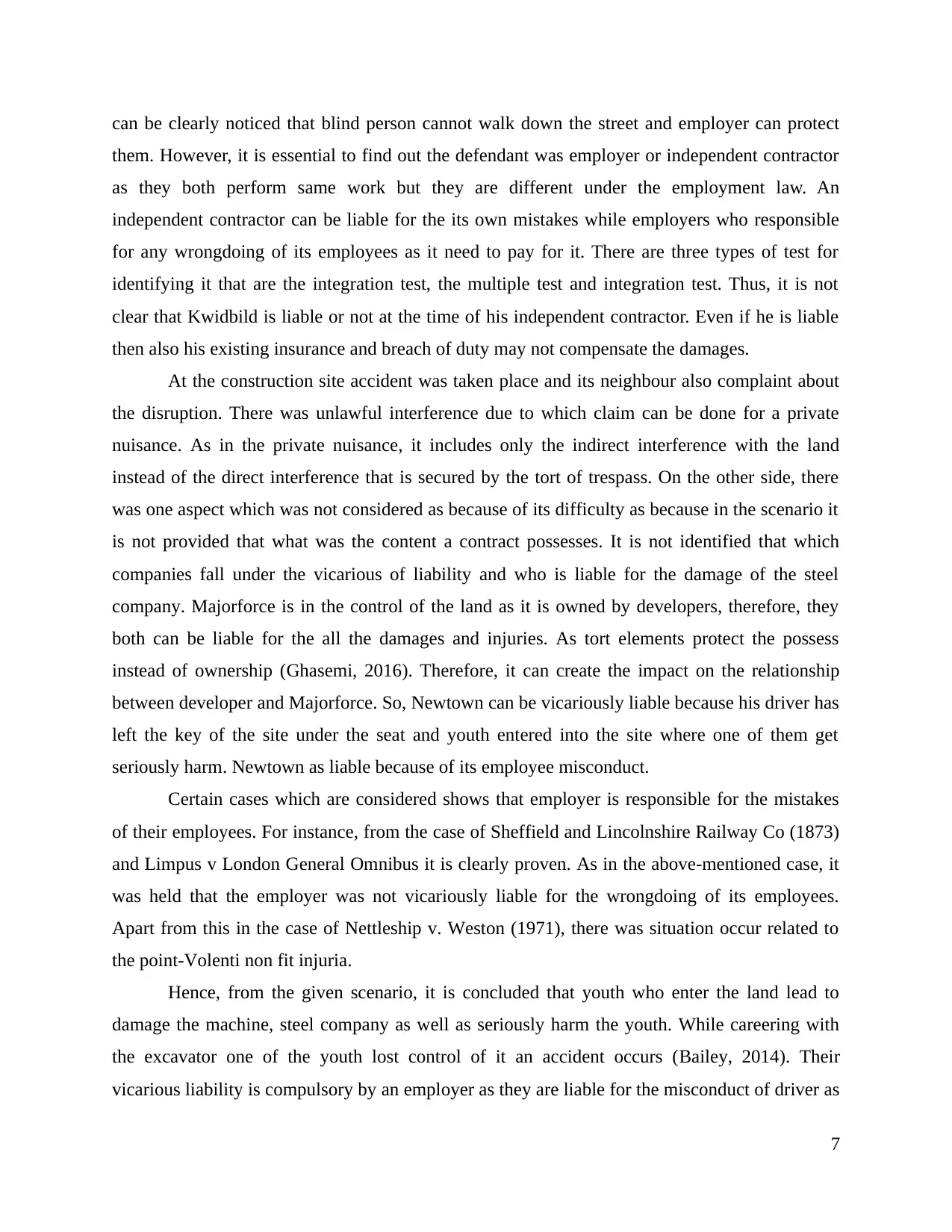
can be clearly noticed that blind person cannot walk down the street and employer can protect
them. However, it is essential to find out the defendant was employer or independent contractor
as they both perform same work but they are different under the employment law. An
independent contractor can be liable for the its own mistakes while employers who responsible
for any wrongdoing of its employees as it need to pay for it. There are three types of test for
identifying it that are the integration test, the multiple test and integration test. Thus, it is not
clear that Kwidbild is liable or not at the time of his independent contractor. Even if he is liable
then also his existing insurance and breach of duty may not compensate the damages.
At the construction site accident was taken place and its neighbour also complaint about
the disruption. There was unlawful interference due to which claim can be done for a private
nuisance. As in the private nuisance, it includes only the indirect interference with the land
instead of the direct interference that is secured by the tort of trespass. On the other side, there
was one aspect which was not considered as because of its difficulty as because in the scenario it
is not provided that what was the content a contract possesses. It is not identified that which
companies fall under the vicarious of liability and who is liable for the damage of the steel
company. Majorforce is in the control of the land as it is owned by developers, therefore, they
both can be liable for the all the damages and injuries. As tort elements protect the possess
instead of ownership (Ghasemi, 2016). Therefore, it can create the impact on the relationship
between developer and Majorforce. So, Newtown can be vicariously liable because his driver has
left the key of the site under the seat and youth entered into the site where one of them get
seriously harm. Newtown as liable because of its employee misconduct.
Certain cases which are considered shows that employer is responsible for the mistakes
of their employees. For instance, from the case of Sheffield and Lincolnshire Railway Co (1873)
and Limpus v London General Omnibus it is clearly proven. As in the above-mentioned case, it
was held that the employer was not vicariously liable for the wrongdoing of its employees.
Apart from this in the case of Nettleship v. Weston (1971), there was situation occur related to
the point-Volenti non fit injuria.
Hence, from the given scenario, it is concluded that youth who enter the land lead to
damage the machine, steel company as well as seriously harm the youth. While careering with
the excavator one of the youth lost control of it an accident occurs (Bailey, 2014). Their
vicarious liability is compulsory by an employer as they are liable for the misconduct of driver as
7
them. However, it is essential to find out the defendant was employer or independent contractor
as they both perform same work but they are different under the employment law. An
independent contractor can be liable for the its own mistakes while employers who responsible
for any wrongdoing of its employees as it need to pay for it. There are three types of test for
identifying it that are the integration test, the multiple test and integration test. Thus, it is not
clear that Kwidbild is liable or not at the time of his independent contractor. Even if he is liable
then also his existing insurance and breach of duty may not compensate the damages.
At the construction site accident was taken place and its neighbour also complaint about
the disruption. There was unlawful interference due to which claim can be done for a private
nuisance. As in the private nuisance, it includes only the indirect interference with the land
instead of the direct interference that is secured by the tort of trespass. On the other side, there
was one aspect which was not considered as because of its difficulty as because in the scenario it
is not provided that what was the content a contract possesses. It is not identified that which
companies fall under the vicarious of liability and who is liable for the damage of the steel
company. Majorforce is in the control of the land as it is owned by developers, therefore, they
both can be liable for the all the damages and injuries. As tort elements protect the possess
instead of ownership (Ghasemi, 2016). Therefore, it can create the impact on the relationship
between developer and Majorforce. So, Newtown can be vicariously liable because his driver has
left the key of the site under the seat and youth entered into the site where one of them get
seriously harm. Newtown as liable because of its employee misconduct.
Certain cases which are considered shows that employer is responsible for the mistakes
of their employees. For instance, from the case of Sheffield and Lincolnshire Railway Co (1873)
and Limpus v London General Omnibus it is clearly proven. As in the above-mentioned case, it
was held that the employer was not vicariously liable for the wrongdoing of its employees.
Apart from this in the case of Nettleship v. Weston (1971), there was situation occur related to
the point-Volenti non fit injuria.
Hence, from the given scenario, it is concluded that youth who enter the land lead to
damage the machine, steel company as well as seriously harm the youth. While careering with
the excavator one of the youth lost control of it an accident occurs (Bailey, 2014). Their
vicarious liability is compulsory by an employer as they are liable for the misconduct of driver as
7
Paraphrase This Document
Need a fresh take? Get an instant paraphrase of this document with our AI Paraphraser

he left the keys under the seat which provide a chance to youth for trespass. At the time of
consulting with Barrister, Majorforce needs to sort all the things related to the breach of the duty
of care by the side of Newtown driver.
8
consulting with Barrister, Majorforce needs to sort all the things related to the breach of the duty
of care by the side of Newtown driver.
8
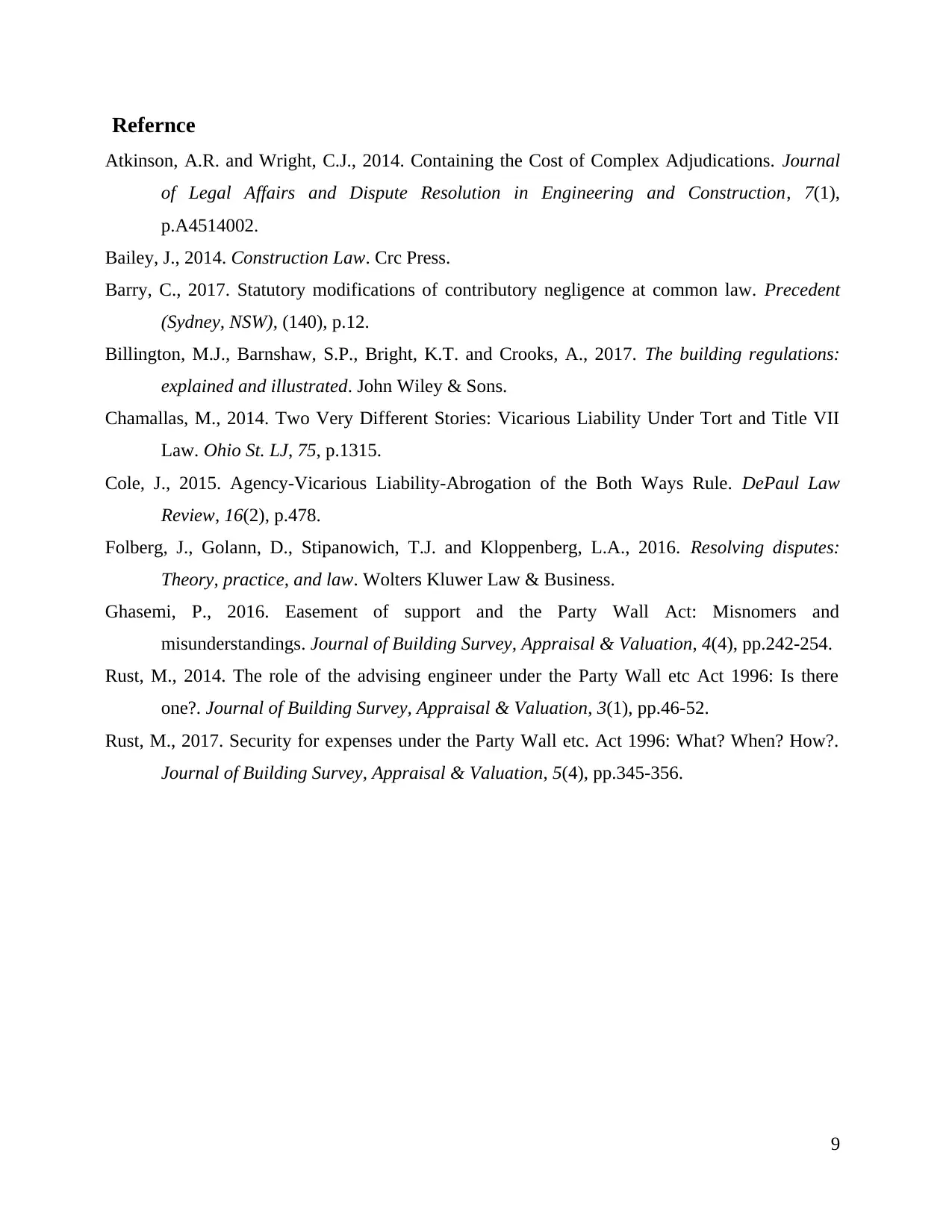
Refernce
Atkinson, A.R. and Wright, C.J., 2014. Containing the Cost of Complex Adjudications. Journal
of Legal Affairs and Dispute Resolution in Engineering and Construction, 7(1),
p.A4514002.
Bailey, J., 2014. Construction Law. Crc Press.
Barry, C., 2017. Statutory modifications of contributory negligence at common law. Precedent
(Sydney, NSW), (140), p.12.
Billington, M.J., Barnshaw, S.P., Bright, K.T. and Crooks, A., 2017. The building regulations:
explained and illustrated. John Wiley & Sons.
Chamallas, M., 2014. Two Very Different Stories: Vicarious Liability Under Tort and Title VII
Law. Ohio St. LJ, 75, p.1315.
Cole, J., 2015. Agency-Vicarious Liability-Abrogation of the Both Ways Rule. DePaul Law
Review, 16(2), p.478.
Folberg, J., Golann, D., Stipanowich, T.J. and Kloppenberg, L.A., 2016. Resolving disputes:
Theory, practice, and law. Wolters Kluwer Law & Business.
Ghasemi, P., 2016. Easement of support and the Party Wall Act: Misnomers and
misunderstandings. Journal of Building Survey, Appraisal & Valuation, 4(4), pp.242-254.
Rust, M., 2014. The role of the advising engineer under the Party Wall etc Act 1996: Is there
one?. Journal of Building Survey, Appraisal & Valuation, 3(1), pp.46-52.
Rust, M., 2017. Security for expenses under the Party Wall etc. Act 1996: What? When? How?.
Journal of Building Survey, Appraisal & Valuation, 5(4), pp.345-356.
9
Atkinson, A.R. and Wright, C.J., 2014. Containing the Cost of Complex Adjudications. Journal
of Legal Affairs and Dispute Resolution in Engineering and Construction, 7(1),
p.A4514002.
Bailey, J., 2014. Construction Law. Crc Press.
Barry, C., 2017. Statutory modifications of contributory negligence at common law. Precedent
(Sydney, NSW), (140), p.12.
Billington, M.J., Barnshaw, S.P., Bright, K.T. and Crooks, A., 2017. The building regulations:
explained and illustrated. John Wiley & Sons.
Chamallas, M., 2014. Two Very Different Stories: Vicarious Liability Under Tort and Title VII
Law. Ohio St. LJ, 75, p.1315.
Cole, J., 2015. Agency-Vicarious Liability-Abrogation of the Both Ways Rule. DePaul Law
Review, 16(2), p.478.
Folberg, J., Golann, D., Stipanowich, T.J. and Kloppenberg, L.A., 2016. Resolving disputes:
Theory, practice, and law. Wolters Kluwer Law & Business.
Ghasemi, P., 2016. Easement of support and the Party Wall Act: Misnomers and
misunderstandings. Journal of Building Survey, Appraisal & Valuation, 4(4), pp.242-254.
Rust, M., 2014. The role of the advising engineer under the Party Wall etc Act 1996: Is there
one?. Journal of Building Survey, Appraisal & Valuation, 3(1), pp.46-52.
Rust, M., 2017. Security for expenses under the Party Wall etc. Act 1996: What? When? How?.
Journal of Building Survey, Appraisal & Valuation, 5(4), pp.345-356.
9
1 out of 9
Related Documents
Your All-in-One AI-Powered Toolkit for Academic Success.
+13062052269
info@desklib.com
Available 24*7 on WhatsApp / Email
![[object Object]](/_next/static/media/star-bottom.7253800d.svg)
Unlock your academic potential
© 2024 | Zucol Services PVT LTD | All rights reserved.





